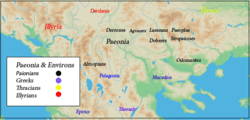Odomanti
Odomanti or Odomantes (Ancient Greek: Ὀδόμαντες) were an ancient Thracian tribe. Some regard it as Paeonian,[1] while others claim, that the tribe was with certainty Thracian.[2] The Odomanti are noted by Herodotus, Thucydides, Stephanus of Byzantium and Pliny the Elder.[3][4][5][6]

The district which they occupied, was called after them, Odomantice (Ὀδομαντική). The tribe were settled upon the whole of the great mountain Orbelus,[7] extending along the northeast of the lower Strymonic plain, from about Melnik (Bulgaria) and Sidirokastro (Greece) to Zikhne inclusive, where they bordered on Pangaion, the gold and silver mines of which they worked with the Pieres and Satrae. (Herod. l. c.) Secure in their inaccessible position, they defied Megabazus. (Herod. v. 16.) The northwest portion of their territory lay to the right of Sitalces as he crossed Mount Cercine; and their general situation agrees with the description of Thucydides (ii. 101), according to whom they dwelt beyond the Strymon to the north, that is to say, to the north of the Lower Strymon, where, alone, the river takes such a course to the east as to justify the expression. Cleon invited Polles, their chieftain, to join him with as many Thracian mercenaries as could be levied. (Thuc. v. 6; Aristoph. Acharn. 156, 164; Suid. s. v. ἀποτεθρίακεν; Leake, Northern Greece, vol. iii. pp. 210, 306, 465.) During the Roman period, most of their land belonged to the territory ("chora") of the ancient city of Sirra (today Serres)[8]
References
- An Inventory of Archaic and Classical Poleis: An Investigation Conducted by The Copenhagen Polis Centre for the Danish National Research Foundation by Mogens Herman Hansen and Thomas Heine Nielsen, 2005, ISBN 0-19-814099-1, page 854: "... Various tribes have occupied this part of Thrace: Bisaltians (lower Strymon valley), Odomantes (the plain to the north of the Strymon)..."
- Thrace in the Graeco-Roman world, p. 112 but others claim that together with the Agrianes and Odomanti, at least the latter of which were with certainty Thracian, not Paeonian.
- Herodotus, VII. 112
- Thucydides, II. 101, v. 6
- Stephanus of Byzantium, s. v.
- Pliny the Elder, IV. 18.
- Archived 2017-04-24 at the Wayback Machine Dimitrios C. Samsaris, Historical Geography of Eastern Macedonia during the Antiquity (in Greek), Thessaloniki 1976 (Society for Macedonian Studies), p. 126-134. ISBN 960-7265-16-5.
- Dimitrios C. Samsaris, A history of Serres (in the Ancient and Roman times) (in Greek), Thessaloniki 1999, p. 137 (Website of Municipality of Serres)
![]()